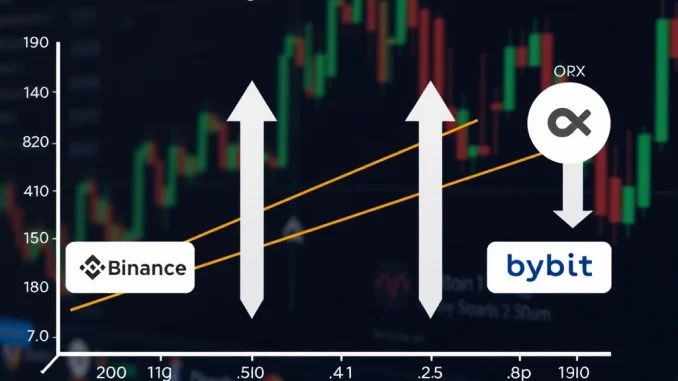
Are you trying to decode the ever-shifting landscape of Bitcoin trading? One powerful tool in a crypto trader’s arsenal is understanding long-short ratios. Today, we’re diving deep into the latest 24-hour long-short ratios for BTC perpetual futures across leading cryptocurrency exchanges. These ratios offer a snapshot of trader sentiment and can be incredibly insightful for your Bitcoin trading strategies. Let’s break down what these numbers mean and how you can use them to your advantage.
Decoding Bitcoin Long-Short Ratios: What Are They?
Before we jump into the numbers, let’s clarify what long-short ratios actually represent. In the world of BTC perpetual futures trading, traders can open two types of positions:
- Long Position: Betting that the price of Bitcoin will go up.
- Short Position: Betting that the price of Bitcoin will go down.
The long-short ratio is simply the proportion of traders currently in long positions versus those in short positions. It’s expressed as a percentage and provides a real-time glimpse into the prevailing market sentiment. A ratio above 50% for longs suggests more traders are bullish, expecting the price to rise, while a ratio below 50% indicates a more bearish outlook.
24-Hour Snapshot: Bitcoin Long-Short Ratios Across Exchanges
Now, let’s get to the heart of the matter – the 24-hour long-short ratios for BTC perpetual futures. Looking at the aggregated data from major cryptocurrency exchanges, here’s what the overall picture looks like:
Total Exchanges: Long 49.51%; Short 50.49%
At first glance, the market appears to be in a near-neutral state, with short positions slightly edging out long positions. However, digging deeper into individual cryptocurrency exchanges can reveal more nuanced insights.
Top Exchange Breakdown: Binance, OKX, and Bybit
Let’s examine the long-short ratios on three of the leading cryptocurrency exchanges:
- Binance: Long 49.59%; Short 50.41%
- OKX: Long 49.74%; Short 50.26%
- Bybit: Long 48.66%; Short 51.34%
Interestingly, across all three exchanges, short positions are marginally higher than long positions. While the differences are small, they consistently point towards a slightly bearish sentiment in the BTC perpetual futures market over the last 24 hours. However, it’s crucial to remember that these are just snapshots in time. Market sentiment can shift rapidly, especially in the volatile world of crypto.
Why are Long-Short Ratios Important for Bitcoin Trading?
You might be wondering, “Why should I care about these long-short ratios?” Here are a few key reasons why they are valuable for Bitcoin trading:
- Gauge Market Sentiment: As mentioned earlier, these ratios provide a direct indication of whether the majority of traders are leaning bullish or bearish. This can be a valuable piece of the puzzle when forming your own market outlook.
- Identify Potential Contrarian Trades: Sometimes, when the market leans heavily in one direction (e.g., extremely high long ratio), it can signal potential overextension and a possible reversal. Contrarian traders might look for opportunities to trade against the prevailing sentiment.
- Confirmation Tool: Use long-short ratios in conjunction with other technical indicators and fundamental analysis. If your analysis suggests a bullish move, but the long-short ratio is heavily skewed towards shorts, it might warrant further investigation or caution.
- Exchange-Specific Insights: Notice how the ratios vary slightly across different cryptocurrency exchanges. This can be due to regional differences in sentiment, user demographics on each platform, or even exchange-specific trading promotions. Monitoring these variations can provide deeper insights.
Challenges and Considerations When Using Long-Short Ratios
While long-short ratios are a useful tool, it’s important to be aware of their limitations:
- Lagging Indicator: Ratios reflect past and present positions. They don’t predict the future. Market sentiment can change very quickly.
- Exchange-Specific Data: The ratios are only representative of traders on specific cryptocurrency exchanges. They don’t encompass the entire global Bitcoin market.
- Manipulation Potential: In less regulated markets, there’s always a theoretical possibility of manipulation, although this is less likely on major, reputable exchanges like Binance, OKX, and Bybit.
- Not a Standalone Indicator: Never rely solely on long-short ratios for trading decisions. Always combine them with other forms of analysis and risk management strategies.
Actionable Insights for Traders
So, how can you practically use this Bitcoin long-short ratio information in your trading?
- Regular Monitoring: Keep an eye on these ratios regularly, especially before making significant trading decisions. Many platforms provide real-time updates.
- Compare Across Exchanges: Look at the ratios across multiple cryptocurrency exchanges to get a broader perspective. Note any significant divergences.
- Backtesting: If you’re developing a trading strategy, consider backtesting how long-short ratios might have influenced past price movements.
- Risk Management: Always use appropriate risk management techniques, regardless of what the ratios suggest. Never trade with more capital than you can afford to lose.
Conclusion: Harnessing the Power of Long-Short Ratios
Understanding long-short ratios for BTC perpetual futures is a valuable skill for any serious Bitcoin trading enthusiast. While today’s data suggests a slightly bearish market sentiment, remember that the crypto market is dynamic and ever-evolving. By incorporating these ratios into your broader analysis, alongside other indicators and sound risk management, you can gain a more informed perspective and potentially enhance your trading decisions. Stay informed, stay vigilant, and happy trading!



